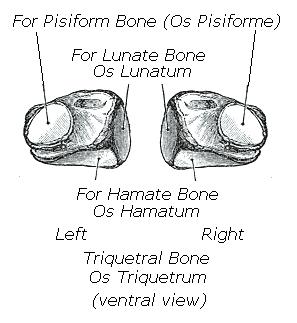User:David Hume/sandbox
The Triangular Bone (os triquetrum; cuneiform bone)
Template:Infobox Bone The triquetral bone (also called triquetrum bone, cuneiform bone, pyramidal bone, cubital bone, three-cornered bone, and triangular bone) is located in the wrist on the medial side of the proximal row of the carpus between the lunate and pisiform bones. It is on the ulnar side of the hand, but does not articulate with the ulna. It connects with the pisiform, hamate, and lunate bones. It is the 3rd most commonly fractured carpal bone.
The triangular bone may be distinguished by its pyramidal shape, and by an oval isolated facet for articulation with the pisiform bone. It is situated at the upper and ulnar side of the carpus. To facilitate its palpation in an exam, the hand must be radially deviated so that the triquetrium moves out from under the ulnar styloid process. The triquetrum may be difficult to find, since it also lies under the pisiform.
The etymology derives from the Latin triquetrus which means "three-cornered."
Surfaces
The superior surface presents a medial, rough, non-articular portion, and a lateral convex articular portion which articulates with the triangular articular disk of the wrist.
The inferior surface, directed lateralward, is concave, sinuously curved, and smooth for articulation with the hamate. The dorsal surface is rough for the attachment of ligaments.
The volar surface presents, on its medial part, an oval facet, for articulation with the pisiform; its lateral part is rough for ligamentous attachment.
The lateral surface, the base of the pyramid, is marked by a flat, quadrilateral facet, for articulation with the lunate.
The medial surface, the summit of the pyramid, is pointed and roughened, for the attachment of the ulnar collateral ligament of the wrist.
See also
Additional images
Template:Bones of upper extremity
fr:Os triquetrum nl:Os triquetrum sk:Trojhranná kosť
By comparison, the term "palm" applies to only the palm (the grasping side) of the hand. The Romans actually used the word "palma" for the outstretched palm of the hand.
Topics in Anatomy
SYSTEMIC ANATOMY Introduction and Systemic Overview
- Anatomical Nomenclature
- Basic Structure and Function of Cells
- Integrating Cells into Tissues
Systemic Overview
- Nervous System
- Blood, Lymphoid Tissues and Haemopoiesis
- Functional Anatomy of the Musculoskeletal System
- Smooth Muscle and the Cardiovascular and Lymphatic systems
- Skin and its Appendages
- Endocrine System
- Principles of Hormone Production and Secretion
- Embryology
- Embryogenesis
- Prenatal and Neonatal Growth
- full skeleton
- axial skeleton
- skull
- vertebral column
- ribcage
- appendicular skeleton
- shoulder & arm
- hand & wrist
- pelvis
- leg & ankle
- foot
- full body
- muscle histology
- head & neck
- thorax
- shoulder & upper arm
- biceps brachii
- forearm & hand
- abdomen
- pelvis
- thigh & knee
- leg & foot
- endocrine system
- hypothalamus & pituitary
- thyroid & parathyroids
- adrenal glands
- pancreas
- ovaries
- testes


